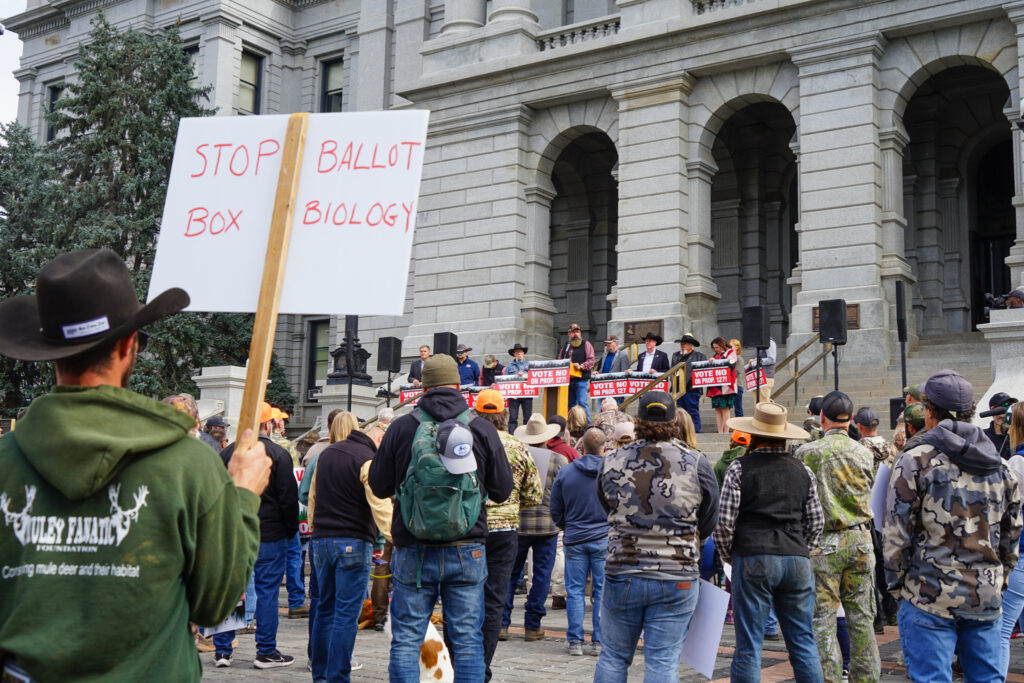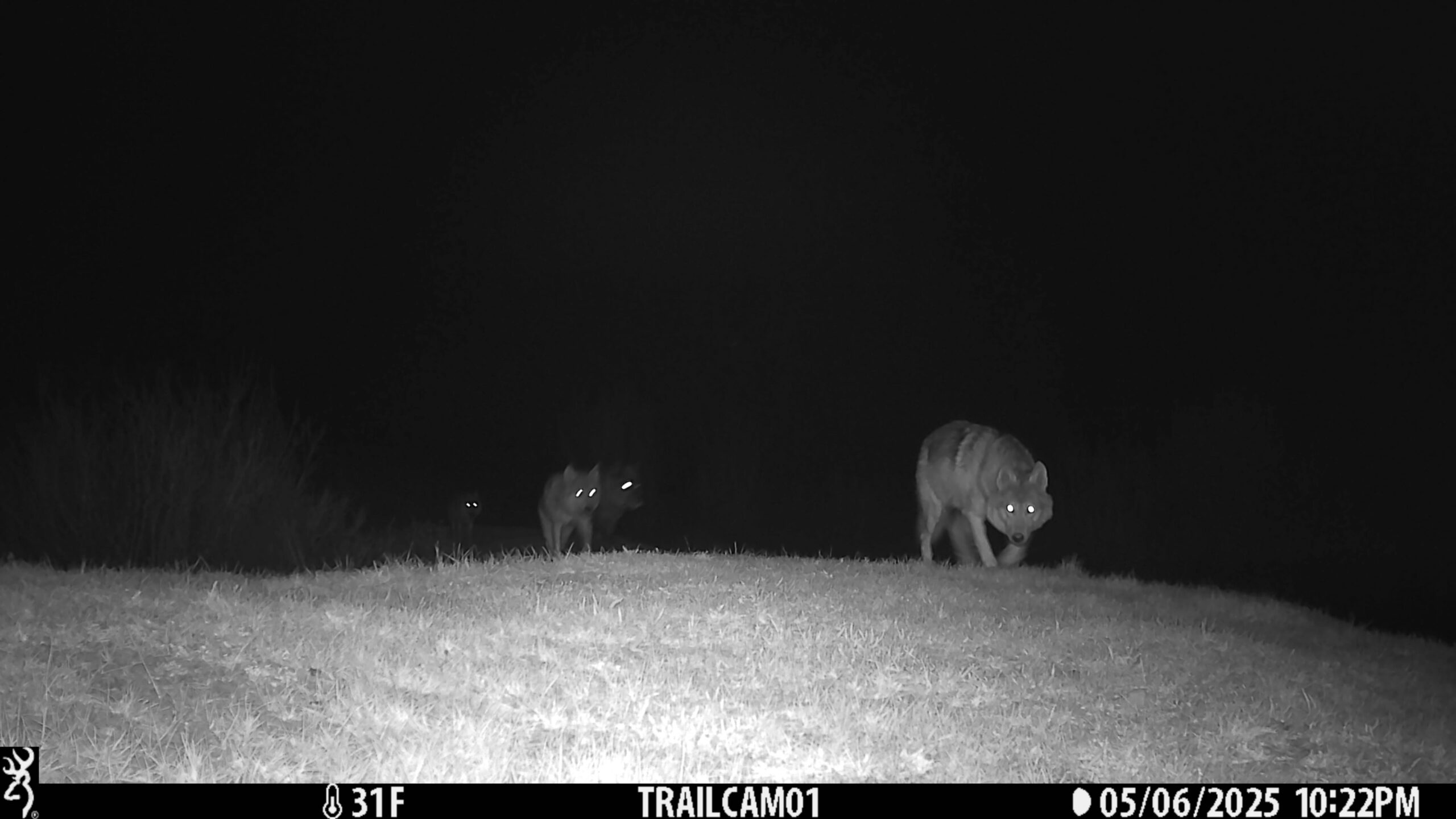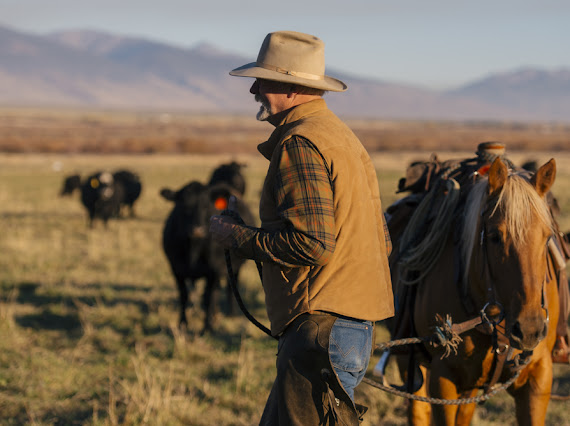(DENVER) — In the fall of 2010, the trees in Boulder Canyon, Colorado were a sea of emerald and gold. Marc Bekoff’s phone pinged with an email. It was from his neighbor across the canyon ridge who wrote: “Mom’s here.”
Bekoff peered out the kitchen window into the surrounding forest, looking for signs of movement or a glimpse of a fur coat. Mom is a mountain lion, so named because she had cubs every two years or so. He knew it would take Mom a few days to traverse south to his home on Canyonside Drive. Mom’s territory was one canyon north. Still, it didn’t stop him from looking.
Wildlife sightings are common around Bekoff’s canyon home. Boulder Canyon snakes up the edge of the Rocky Mountain foothills, and pockets of homes like Bekoff’s flank the canyon’s sides, straddling the ever-rumbling Boulder Creek. Deer, foxes, owls, black bears, and coyotes, were common visitors. A professor emeritus of ecology and evolutionary biology at the University of Colorado, Boulder, he understands that his home sits right in the middle of “their living room,” and he was the intruder. Coexistence was the least he could do.
An urban-rural split
On the western slope of the Continental Divide in Craig, Christopher Jurney, a hunter by family tradition, looked out his window and saw an abundant forest that chirped, howled, and croaked of creatures large and small that walked beyond what his eyes could see. Having grown up an outdoorsman and in the mountains, Jurney was accustomed to the relationship between predator and prey. Just as an apex predator could maintain a balanced ecosystem by keeping prey populations in check, he saw himself, the human hunter, as the ultimate predator and enforcer of the balance.
Despite sharing a commitment to wildlife conservation, Bekoff and Jurney checked different boxes last month for Colorado’s Prop 127, a measure to ban bobcat, lynx, and mountain lion hunting in the state.
According to Ballotpedia, the law failed to pass with 54.7% of Colorado voters rejecting it.
Following the decision on Prop 127, the divide between Colorado’s urban and rural residents has grown more pronounced, underscoring the challenges of reconciling differing visions for coexistence with nature. With votes split almost evenly along political lines — with blue counties largely supporting the measure and red counties opposing it — the results highlighted a persistent rift in how Coloradans perceive wildlife protection and conservation.
The decision by voters to allow hunting to continue, set against the backdrop of Donald Trump’s return to the White House, added another layer of tension. Trump’s history of rolling back environmental regulations heightened anxieties on both sides of the debate, amplifying concerns about the future of conservation policy under his administration.
The failure of Prop 127 marks more than just a political decision—it signals an urgent need to bridge ideological gaps, foster mutual understanding, and forge a unified approach to the delicate balance of protecting wildlife while respecting the livelihoods and traditions of those closest to it.
Without this, Colorado’s conservation efforts may remain stymied by division rather than strengthened by collaboration.
From nuisance to neighbor
In Colorado during the early 1900s, big cats like mountain lions and other large predators were a nuisance to residents, killing livestock and terrorizing ranchers. The state set bounties for kills, shooting and trapping were commonplace, and lion killers became revered heroes touting the number of big cats they had killed.
There are no reliable estimates to the number of big cats killed during that period, but by the late 1960s, big cats were hunted to near extinction across the mountain state according to the Colorado Parks and Wildlife. The proposed ban came as big cat populations in Colorado have long since rebounded from historic lows.
As science journalist David Baron observed in his 2004 book, “The Beast in the Garden,” once the lions disappeared, residents began wanting them back.
Baron observed that the shift in attitude began in Colorado’s urban centers, especially Boulder. Liberal, affluent, and nature-loving. A typical community notice board in downtown Boulder would advertise yoga classes, second-hand bikes for sale, and health food stores. Boulder residents’ reluctance to deal with the ballooning deer population in town eventually led to the rebounding mountain lion population, which moved closer to the Front Range in search of their favorite meal of deer, or often someone’s beloved pet. Despite the concerning high number of missing cats and dogs attacked, as documented in Baron’s book, Colorado’s urban residents did not want to see lions killed.
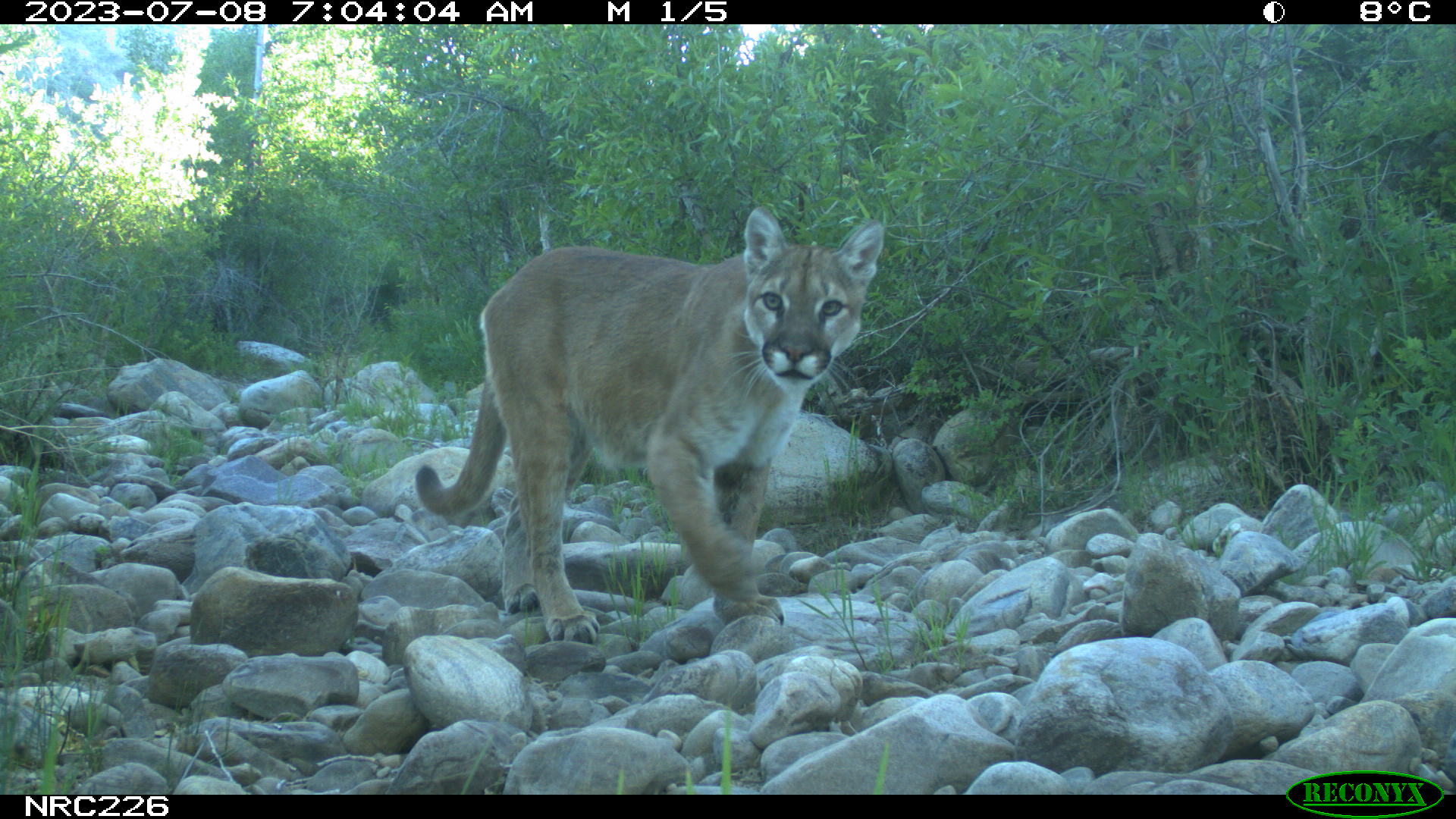
A mountain lion near the Colorado-New Mexico Border captured by a wildlife camera. [Credit: Sierra McMurry]
Famously elusive, mountain lions are hunted with specially trained hounds. Hunters released GPS-collared hounds into the forest, tracking the scent of a lion and chasing it through the forest, terrifying the cats into trees where they are shot down by the hunter.
The conservationist and the environmentalist
Baron made the comparison between the two kinds of lions that are still relevant two decades later: Roosevelt and Abbey. The former president Theodore Roosevelt saw conservationism as a sustainable harvest, with efforts to ensure it remained bountiful for the following generations. Edward Abbey saw conservation as leaving it untrammeled and untouched.
The Prop 127 debate, reflecting Roosevelt and Abbey’s respective lions, has become one of the most high-profile and heavily funded ballot initiatives in recent state history.
The real mountain way of life
On Oct. 18 Jurney got into his mud-splattered pickup and drove down the mountains into Denver. It was the first cold day of the winter, and the temperature down in town wasn’t much better than the mountains. A bitter wind whistled through the streets, scattering freshly felled leaves, signaling the end of leaf-peeping tourists and prime waterfowl hunting season. Jurney pulled on a fleece vest sporting his outfitter’s name and logo: Ponderosa Outfitters, which won the 2012 Colorado Outfitters Association Outfitter of the Year. Jurney has been running both the outfitter, and a wildlife control business since 1986.
There was a rally for the opposition of Prop 127 organized by the opponents of the ban, Colorado’s Wildlife Deserves Better, at the Colorado State Capitol Building. Jurney met his longtime friends Brandon Powell and Bruce Ayers, and together they grabbed some campaign signs and stood sentinel in the crowd, all cowboy hats and denim. The air smelled faintly of tobacco smoke and the baying of hunting hounds—ow ow owuuu—broke the monotonous sounds of downtown traffic.
Even though Prop 127 wouldn’t affect Jurney’s outfitter, since they primarily hunt waterfowl, he saw Prop 127 as an attack on the traditional mountain way of life and wildlife management.
“I was born and raised here, so I’m native of Colorado,” Jurney said. He stood proud like a soldier as he spoke. “My way of life—hunting, fishing, trapping—is what I’ve always done. People don’t understand that wildlife needs to be managed. They’re renewable resources and hunting is a manageable tool.”
Samantha Miller, the campaign manager of Cats Aren’t Trophies (CAT), is quick to point out that CAT isn’t against all hunting, only cruel lion hunts and bobcat trappings. “I hunt and fish myself,” said Miller. Living in rural Grant County, she spends her life outdoors. The soft-spoken Miller’s brow furrowed as she spoke, “The way mountain lions are hunted is unfair and unethical,” she said, pointing to a slew of social media footage of a terrified lion in a tree while the terror of hounds reigned below, followed by grinning bearded men posing with blood-soaked, dead lions.
A crowd of over a hundred gathered outside the Colorado State Capitol Building. The mood was somber, except for a camouflage-clad man who shouted “Colorado, baby!” in jovial glee from the back of the crowd. Speakers at the rally pointed fingers at the supporters of Prop 127 as ignorant urban voters who did not understand hunting as a wildlife management tool. They claimed it was “ballot box biology” at work, referring to the voting patterns of unknowing urban residents swayed emotionally by gory pictures of dead lions and bobcats voted about wildlife management strategies. They pointed to the California hunting ban of 1990 or Colorado’s reintroduction of wolves in 2020, and cited their ineffectiveness, to which the crowd nodded and cheered. The campaign slogan for the opposition’s organizing non-profit, Colorado’s Wildlife Deserves Better, is “leave wildlife management to the scientists.”
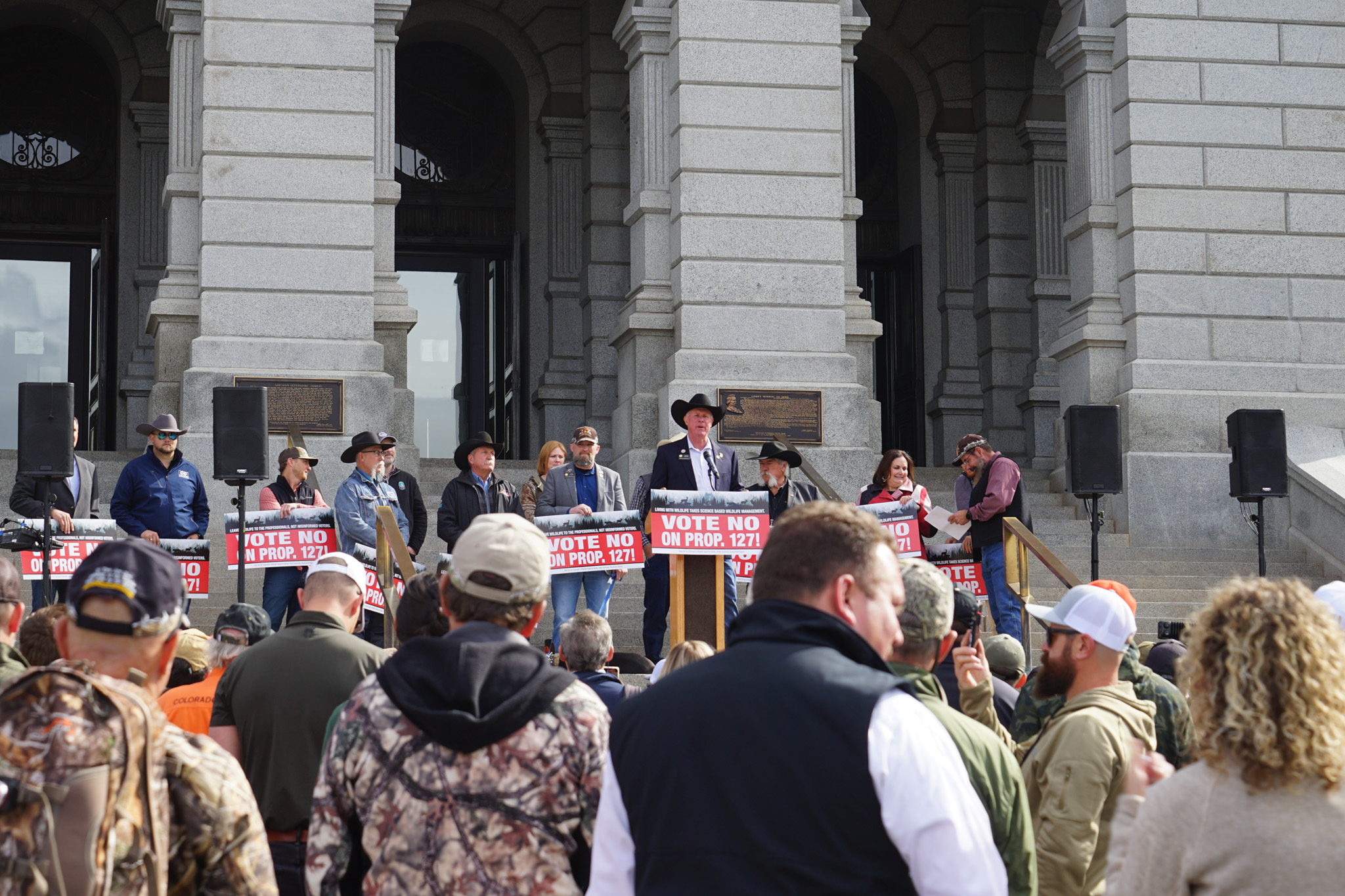
Speakers at the “No on Prop 127” rally at a Colorado State Capital Building [Credit: Holly Yu Tung Chen]
Bekoff lives in town now after the 2013 Colorado floods complicated access to his Canyonside Drive home where he’d lived for more than three decades.
He scoffed at the opposition’s accusations and slogan. Studies have found no evidence on the “regulating impact on [mountain lion or big cat populations],” said Bekoff, who has spent decades researching animal behavioral ecology. Even if the hunter chooses not to kill a treed lion —if it were a young female or a lion with kittens — the fear may alter their emotional state, permanently causing them to leave their home range, abandon kittens, or become unable to raise their litter.
Regardless, the vegan animal expert saw hunting as an anthropocentric approach to wildlife conservation when it could be an ecocentric one. “What right do I or other people have to just go out and kill animals for fun?” Bekoff asked.
Ballot box biology v. ballot box morality
At the rally outside the Colorado State Capitol, Jurney expressed fear for his fellow mountain residents who make a living as houndsmen and women, own big game outfitters, or guide clients looking for big cat trophies. Hound hunting is a century-old tradition where hunters use dogs, sometimes known as “lion hounds,” to track and assist in their hunts.
Houndsmen Chase Rupp was also there, dressed in hunter’s camouflage. His two foxhounds, dressed in make-shift t-shirts that said “save my job,” stood silently at his heels.
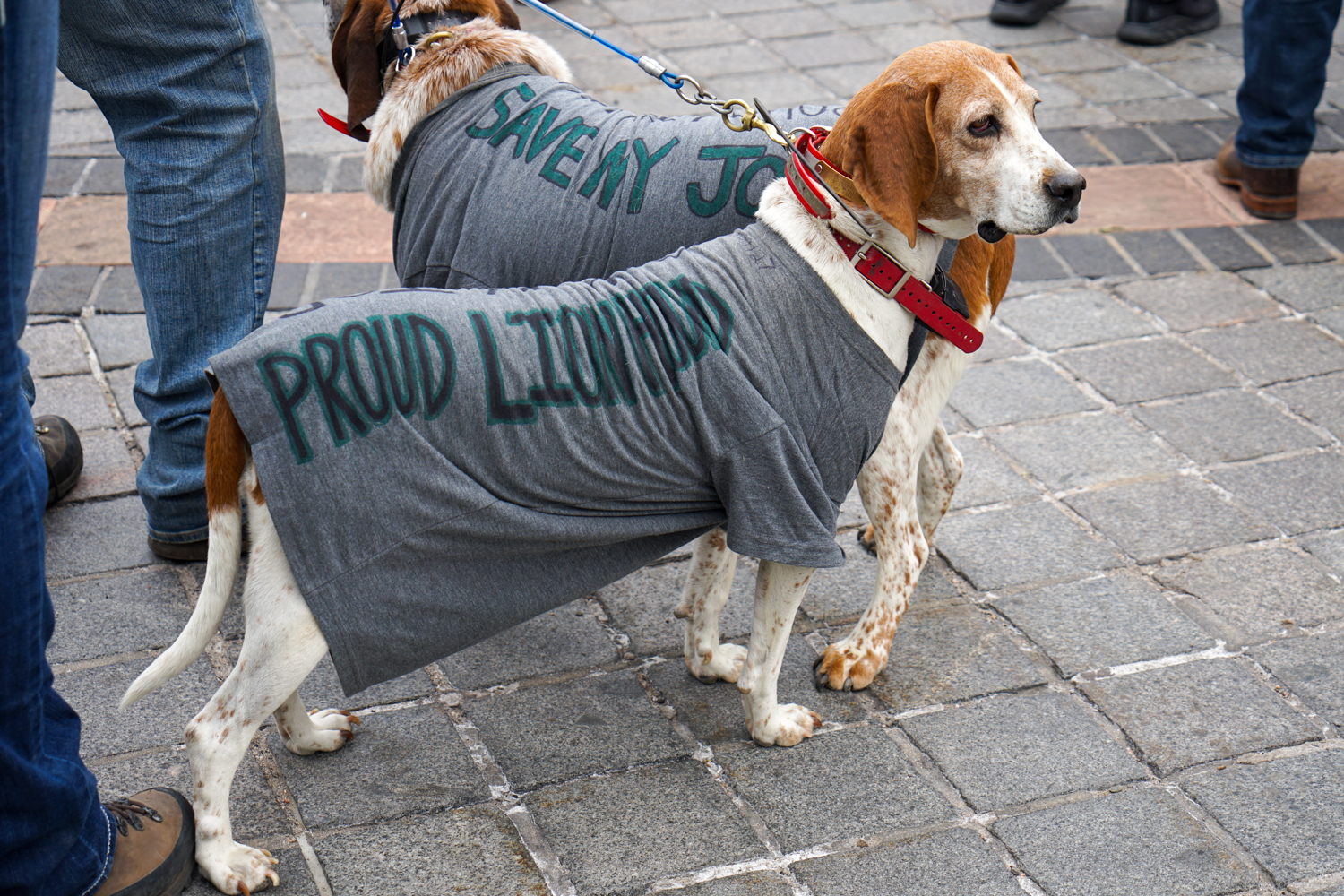
A pair of “lion hounds” join the rally at the state capitol. [Credit: Holly Yu Tung Chen]
Houndsmen say their dogs “speak” to them. They know the differences between a bay, a howl, or a bark that means, “I’m on the trail,” “I’ve lost the trail,” or “The lion is treed.”
Sometimes, without the use of the GPS collar, hunters follow the speaking hounds to the tree where the lion crouched, hiding. It was no match for modern weaponry. The best lion hunters, according to Rupp, are the ones who know how to train their hounds best. It’s not about the gun, it’s about your dogs.
Rupp said he raised his dogs himself, and insists that dog-assisted lion hunts are the most ethical way to hunt, emphasizing the ability to properly look at the target lion before killing it. “We love to see [our dogs] do what they’re born to do, what they’re bred to do,” said Rupp.
“They say ballot box biology, others and I say ballot box morality,” said Bekoff, referring to himself voting to align with his moral values.
Both sides of the campaign attracted significant donations from a mix of local and out-of-state organizations, underscoring the contentious nature of the issue.
Common and uncommon ground
While the measure’s failure preserves hunting as a management tool, it does not resolve the underlying tensions. The debate rages on, as fierce and enduring as the cats at its center.
The dispute over big cat hunting reflects the complexity of living with apex predators in a rapidly changing world. Whether through Roosevelt’s vision of sustainable use or Abbey’s ideal of untouched wilderness, Coloradoans are grappling with how best to share their landscape with one of its most iconic inhabitants. The big cats, elusive and majestic, remain a symbol of the wild—one that challenges humans to reflect on their role in the natural order.
While Coloradans like Jurney and Rupp celebrated the victory, both expressed concern that the protection for hunters may be temporary. With waterfowl hunting season in full swing, Jurney has a fully booked schedule, taking hunters out on guided trips to connect with the land. He continues to maintain that hunting is not just a tool for managing wildlife but a cultural touchstone, a way of life passed down through generations.
Both Bekoff and Miller expressed their deep disappointment at the election’s outcomes over the phone. Bekoff, having just finished a long, gravel bike ride in the woods, commented on the beauty of the landscape despite the fierce winter winds that tore at him and the failure of Prop 127. “It’s a funky world out there,” he said.
Correction: A previous version of this story stated that Bekoff’s home was destroyed in the 2013 floods. His home was not destroyed. Instead, the floods made it difficult to access his home. The Click regrets the error.
